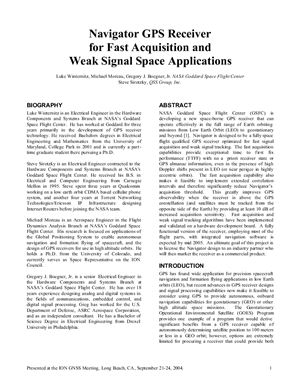ABSTRACT
NASA Goddard Space Flight Center (GSFC) is developing a new space-boe GPS receiver that can operate effectively in the full range of Earth orbiting missions from Low Earth Orbit (LEO) to geostationary and beyond [1]. Navigator is designed to be a fully space flight qualified GPS receiver optimized for fast signal acquisition and weak signal tracking. The fast acquisition capabilities provide exceptional time to first fix performance (TTFF) with no a priori receiver state or GPS almanac information, even in the presence of high Doppler shifts present in LEO (or near perigee in highly
eccentric orbits). The fast acquisition capability also makes it feasible to imp lement extended correlation intervals and therefore significantly reduce Navigator’s acquisition threshold. This greatly improves GPS observability when the receiver is above the GPS constellation (and satellites must be tracked from the opposite side of the Earth) by providing at least 10 dB of increased acquisition sensitivity. Fast acquisition and weak signal tracking algorithms have been implemented and validated on a hardware development board. A fully functional version of the receiver, employing most of the flight parts, with integrated navigation software is expected by mid 2005. An ultimate goal of this project is to license the Navigator design to an industry partner who will then market the receiver as a commercial product.
NASA Goddard Space Flight Center (GSFC) is developing a new space-boe GPS receiver that can operate effectively in the full range of Earth orbiting missions from Low Earth Orbit (LEO) to geostationary and beyond [1]. Navigator is designed to be a fully space flight qualified GPS receiver optimized for fast signal acquisition and weak signal tracking. The fast acquisition capabilities provide exceptional time to first fix performance (TTFF) with no a priori receiver state or GPS almanac information, even in the presence of high Doppler shifts present in LEO (or near perigee in highly
eccentric orbits). The fast acquisition capability also makes it feasible to imp lement extended correlation intervals and therefore significantly reduce Navigator’s acquisition threshold. This greatly improves GPS observability when the receiver is above the GPS constellation (and satellites must be tracked from the opposite side of the Earth) by providing at least 10 dB of increased acquisition sensitivity. Fast acquisition and weak signal tracking algorithms have been implemented and validated on a hardware development board. A fully functional version of the receiver, employing most of the flight parts, with integrated navigation software is expected by mid 2005. An ultimate goal of this project is to license the Navigator design to an industry partner who will then market the receiver as a commercial product.

